hankyoreh
Links to other country sites 다른 나라 사이트 링크
Who says winter isn’t island time? Kick back on some of Sinan’s 1,004 islands
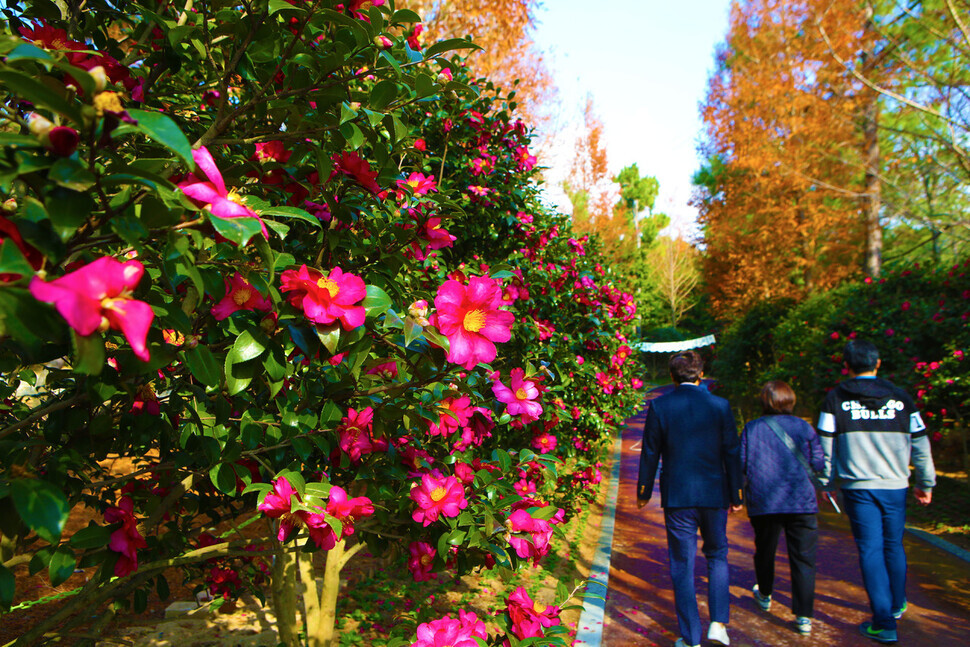
Sinan County, South Jeolla Province, is made up of a cluster of islands on the southwestern corner of the Korean Peninsula. The county consists of 1,025 islands altogether; as of 2020, 76 of them were inhabited and 949 uninhabited. Of the total, 1,004 are hospitable to flora like grass and trees, giving the county its nickname of “Angel Islands” — based on homonymy between the Korean for “1,004” and “angel” (cheonsa).
The county is also recognized internationally for its outstanding natural environment. Already home to a UNESCO biosphere reserve, a Ramsar wetland, and a slow city, it now has something new to brag about. On Dec. 2, Banwol and Bakji islands, better known as “Purple Island,” were included on a list of Best Tourism Villages selected by the UN World Tourism Organization.
That’s not all that Sinan has going for it. Since everywhere you go in the county is an island, the whole area is perfect for some socially distanced traveling. I headed down to Sinan County on Dec. 9 with the hope of seeing some lonesome and untouched island villages as the year neared an end.
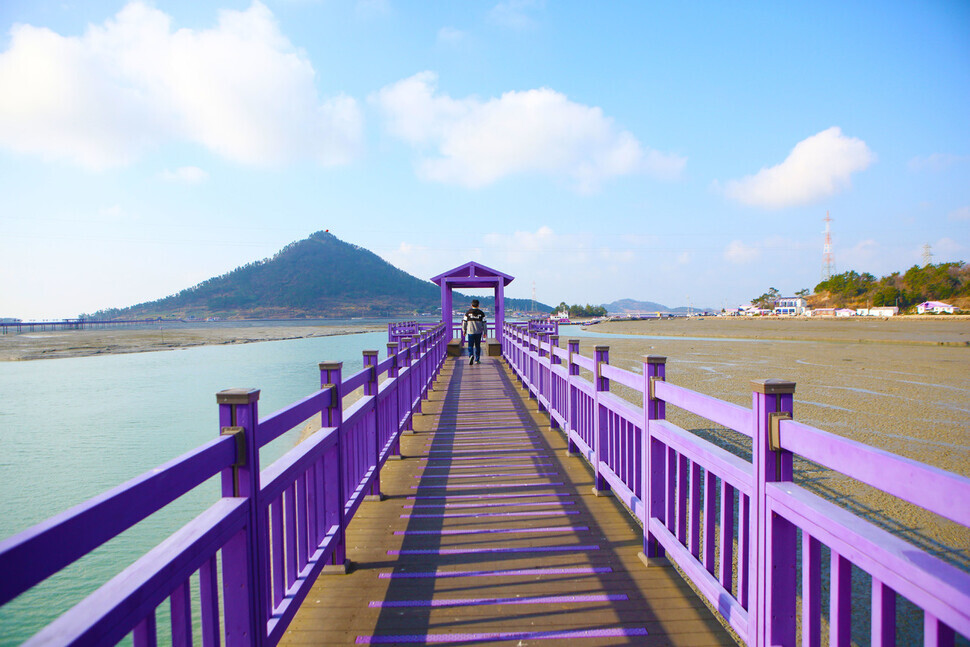
Over the past few years, Banwol and Bakji islands have become a hot spot in Sinan County. Collectively, they’re known as “Purple Island” because everywhere you look, you see more of the color.
To get to Purple Island — nestled between the main islands of Sinan County — you have to cross the 547-meter Purple Bridge, which begins at a dock on Anjwa Island. In case you didn’t pick up on the name, the whole bridge is painted a brilliant shade of purple.
While I was crossing Purple Bridge, the tide went out, allowing me to view the mudflats that stretch out into the horizon. This wooden sea bridge was built in 2007 to satisfy the wish of a long-time resident of Bakji Island named Kim Mae-geum. Kim had always wanted to be able to cross over to Anjwa Island on foot.
Banwol and Bakji islands reinvented themselves as Purple Island when they were selected as “islands worth a visit” by South Jeolla Province in 2015. The purple theme was inspired by the bellflowers of that color that grow on the islands. Visitors to the island find that everything is purple: the wooden bridge, the seaside walking paths, the village roofs, the warehouse walls — even the utensils.
When I was on Purple Island, I saw tourists wearing purple masks and purple clothing. The admission fee is normally 5,000 won, but you can get to the island for free if you’re wearing purple clothes or a purple backpack or hat.
After crossing the bridge to Bakji Island, I came upon a small sign that tells a heartrending love story related to the island: the legend of Monk’s Crossing.
Monk’s Crossing is said to have been a low-water bridge on which a male monk from Bakji Island and a female monk from Banwol Island had a tragic encounter. Back when there wasn’t a bridge linking the two islands, the two monks met for the first time after completing the walkway by stacking up rocks in Gwangju village. It’s said that the two held hands and cried endless tears there. When the tide came in, the two were lost to sight, and when the water washed out again, only Monk’s Crossing remained.
In the vicinity of the sign relating this legend, I spotted some modern-looking sculptures. One depicts a gourd, a symbol of Bakji Island, while the other shows the Little Prince, from the eponymous novel, sitting atop a quarter moon, a symbol of Banwol Island. Sure enough, the road that leads up to those sculptures is painted purple.
The island’s purple tint seemed to bring a hint of warmth to the desolation of winter.
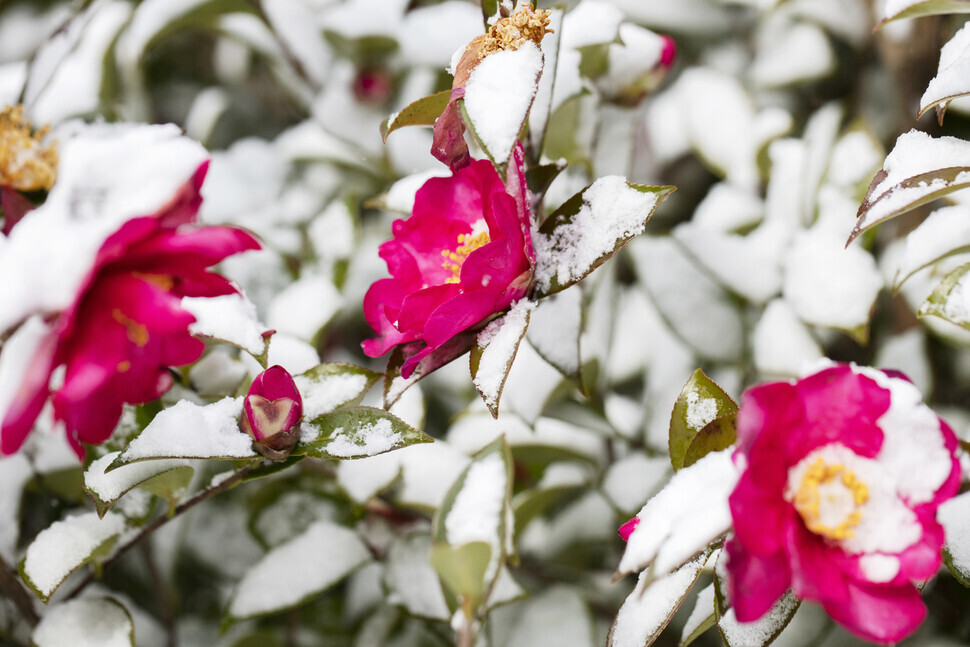
Cheonsaseom Bunjae Park, known also as Angel Island Bonsai Park, in Sinan County’s Ap-hae township, was festooned in red. A festival for winter flowers — focusing on the sasanqua camellia, which blooms in the winter — is scheduled to run through the end of January. The leaves and flowers of the sasanqua camellia are similar to, but smaller than, the common camellia.
Visitors to the park can admire 30 million sasanqua camellia blossoms while walking along 3 kilometers of flower-bedecked walking paths.
The festival grounds are open from 9 am to 5 pm each day except Monday, when the festival staff have the day off. For adults, admission costs 5,000 won. A number of programs run during the festival, including making dalgona honeycomb toffee, writing a postcard to oneself, and jotting down wishes and resolutions for the New Year.
When I reached the sasanqua camellia path at the park, I saw the round flowers in bloom on the trees. The buds were just starting to unfurl on these red, white, and pink flowers that paid little mind to the harsh cold of winter. The flowers’ variegated hues caused visitors to halt their steps and stare. After a snowfall, I’m told, the red of the sasanqua camellia flowers looks even sharper against the white backdrop.
There’s plenty to see at Cheonsaseom Bunjae Park, which occupies 13 hectares of space on the slopes of Songgongsan Mountain.
In the greenhouse and garden grow over 400 bonsai — in Korean, bunjae — trees, including golden umbrella pines, black pines, hornbeams, royal azalea, yews, and junipers, and some 200 Shona sculptures from Africa are also on display.
The park is also the home of the Sunset Museum, which displays Asian-style paintings by Park Yong-kyu, also known by the pen name U-am. The museum operates a reading cafe that includes around 5,000 books, including not only specialized texts on art but also books for a more general readership.
Especially moving is the view of the ocean and surrounding islands from the Cheonsaseom Bunjae Park. A leisurely walk along the well-kept forest trail is apt to leave visitors stunned when a view opens up upon the broad expanse of the ocean. Tiny islands can be seen in the distance as boats bob on the gently rolling waves.
It’s a peaceful view of the sea, encountered in an island forest.
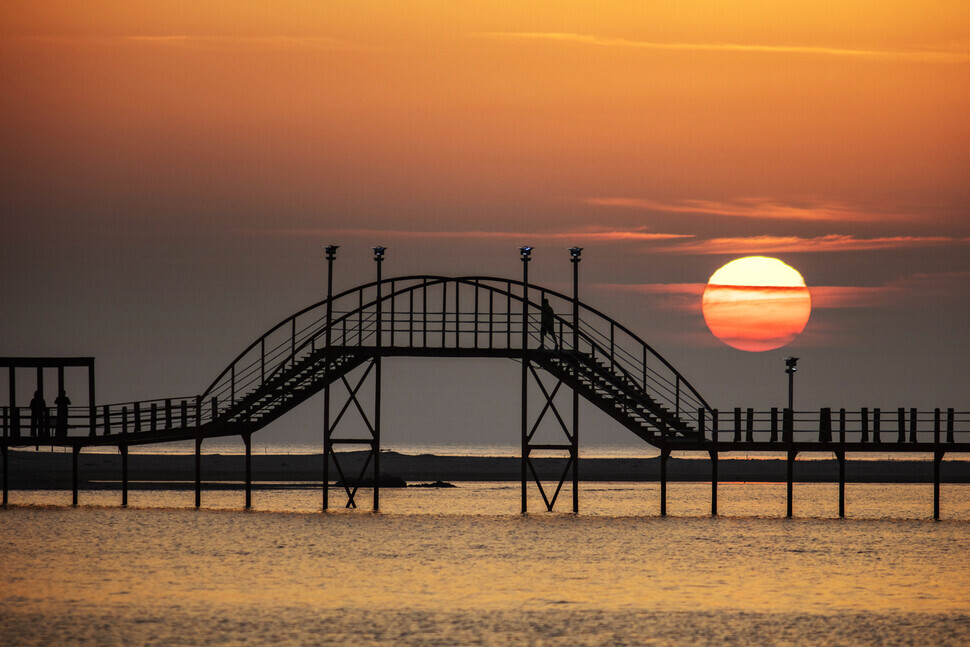
Another island can be visited on the other side of the bridge. Designated a “slow city” in 2007, Jeungdo Island is a place meant for taking things slow and basking in the beauty of nature.
It also boasts many tourist highlights. One of them is the 470-meter wooden Jjangttungeo (mudskipper) Bridge, so named for the many mudskippers that inhabit the tidal flats. These fish have bulging eyes, large heads, and egg-shaped bodies.
Crossing the bridge at low tide, visitors can see a variety of aquatic life on the tidal flats, including fiddler crabs, sentinel crabs, clams, and mudskippers. At high tide, it feels like walking on the sea itself. When the sun sets, it becomes a premier location for taking in a beautiful landscape.
Over the Jjangttungeo Bridge is a mudskipper beach. This hidden locale is known only to those in the know.
The quiet setting had no one in sight when I visited — just parasols made from straw and bush clover. The silvery beach was soft and fine.
“People come here on weekends for car camping,” explained culture and tourism commentator Cho Su-won.
“We’re also seeing more and more families visiting for walks in the Hanbando Haesongsup coastal forest, a thick pine forest just behind the beach.”
Boasting around 100,000 pine trees, the Haesongsup has a flat walking trail with no unexpected inclines, which has made it a popular hiking course.
To get to the islands, you have to cross bridges of various sizes — some linking one island to another, others connecting to the mainland. The bridges between islands include some paved with pebbles and others with stepping-stones.

It is one of these stepping-stone bridges that visitors must cross to reach Hwado, an island about 1.2 km from Jeungdo.
Crossing a stepping-stone bridge is different from crossing one of large, tall bridges. A walk across a low stepping-stone bridge is an opportunity to see the broad tidal flat expanse from up close. But the bridge can only be crossed at low tide, as they are submerged when the tide is high.
The tidal flat visible on the way to Hwado is the broadest of all Jeungdo’s flats. Jeungdo has well-preserved tidal flats of various types, including mudflats, sand flats and mixed flats.
Considered one of the world’s top five wetlands, the southwest Korean coastal flat region around Jeungdo is famous for being preserved in its original state.
In addition to the tidal flats, salt farms are another essential stop for the Jeungdo visitor.
The island is home to the Taepyeong Salt Farm, the largest of its kind in Korea. Its area is 4.62 million square meters, or roughly twice the size of Yeouido. It’s also designated as Cultural Heritage of Early Modern Times No. 360.
Near the Taepyeong Salt Farm is the Taepyeong Halophyte Garden, where visitors can see around 70 types of halophytes (salt-tolerant plants) including glasswort and East Asian seepweed. Many visitors come to take pictures in the fall, when the glasswort and seepweed turn red like maple leaves.
Also near the Taepyung Salt Farm is the Salt Museum, which shares information about the history of salt and its different varieties and characteristics. The museum is open from 9:30 am to 6 pm. Admission is 3,000 won for adults.
Opposite the museum is the Sunset Observatory — another exquisite visual experience that shouldn’t be missed.
To get to the observatory, you have to climb a low hill rising up about 50 meters above sea level. Once you’re at the top, you’ll be able to see the checkerboard pattern of the Taepyung Salt Farm, along with the sea, the mountains, and Jeungdo Bridge. If you check the sunset schedule and pick the right time to come, you can get a view of the island sunset to boot.
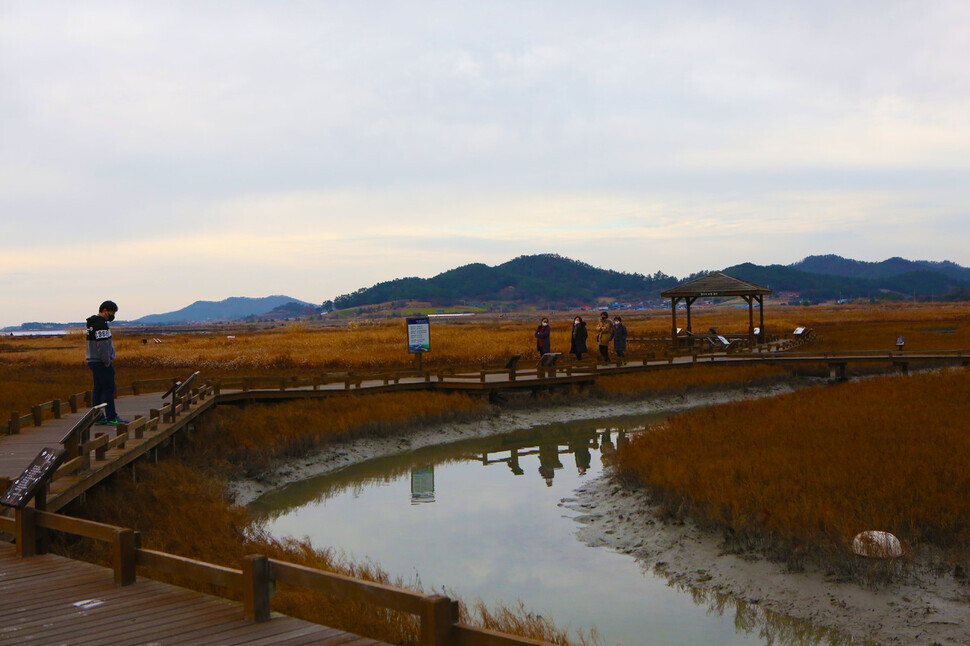
■Sinan island travel information
The fastest route from Seoul is by KTX high-speed trade from Yongsan Station to Mokpo Station. The first train of the day departs at 5:10 am, while the last leaves at 10:25 pm. Nineteen trains run per day, with the trip lasting two hours and 30 minutes. The fare is 52,800 won.
To get to Purple Island, take the No. 2004 bus from Mokpo Terminal and disembark at Eupdong Intersection in Anjwa Township. From there, take the Anjwa village bus (four round trips per day) and get off at Purple Bridge (Duri Village wharf).
To get to Jeungdo, visitors can take the bus to Jido Bus Terminal, which departs twice a day (7:30 am and 4:20 pm) from Seoul’s Central City Terminal (02-6282-0114). The trip lasts four hours and 10 minutes and costs 37,200 won. Once you disembark at Jido, Jeungdo is a 15-minute bus ride away.
Car rentals are also available at Mokpo Station. Purple Island, Jeungdo Island, and Ap-hae Island all have bridges that are accessible by car.
By Her Yun-hee, staff reporter
Please direct questions or comments to [english@hani.co.kr]

Editorial・opinion
![[Column] Season 2 of special prosecutor probe may be coming to Korea soon [Column] Season 2 of special prosecutor probe may be coming to Korea soon](https://flexible.img.hani.co.kr/flexible/normal/500/300/imgdb/original/2024/0426/3317141030699447.jpg) [Column] Season 2 of special prosecutor probe may be coming to Korea soon
[Column] Season 2 of special prosecutor probe may be coming to Korea soon![[Column] Park Geun-hye déjà vu in Yoon Suk-yeol [Column] Park Geun-hye déjà vu in Yoon Suk-yeol](https://flexible.img.hani.co.kr/flexible/normal/500/300/imgdb/original/2024/0424/651713945113788.jpg) [Column] Park Geun-hye déjà vu in Yoon Suk-yeol
[Column] Park Geun-hye déjà vu in Yoon Suk-yeol- [Editorial] New weight of N. Korea’s nuclear threats makes dialogue all the more urgent
- [Guest essay] The real reason Korea’s new right wants to dub Rhee a founding father
- [Column] ‘Choson’: Is it time we start referring to N. Korea in its own terms?
- [Editorial] Japan’s rewriting of history with Korea has gone too far
- [Column] The president’s questionable capacity for dialogue
- [Column] Are chaebol firms just pizza pies for families to divvy up as they please?
- [Column] Has Korea, too, crossed the Rubicon on China?
- [Correspondent’s column] In Japan’s alliance with US, echoes of its past alliances with UK
Most viewed articles
- 1No good, very bad game for Korea puts it out of Olympics for first time since 1988
- 2Division commander ordered troops to enter raging flood waters before Marine died, survivor says
- 3Korea’s 1.3% growth in Q1 signals ‘textbook’ return to growth, says government
- 4Will NewJeans end up collateral damage in internal feud at K-pop juggernaut Hybe?
- 5[Column] Season 2 of special prosecutor probe may be coming to Korea soon
- 6[Editorial] Korea’s surprise Q1 growth requires objective assessment, not blind fanfare
- 7[Column] ‘Choson’: Is it time we start referring to N. Korea in its own terms?
- 8‘We must say no’: Seoul defense chief on Korean, USFK involvement in hypothetical Taiwan crisis
- 9Korea sees more deaths than births for 52nd consecutive month in February
- 10Is N. Korea threatening to test nukes in response to possible new US-led sanctions body?